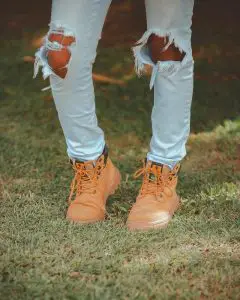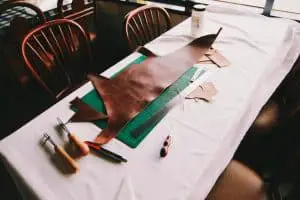Most people believe that artificial intelligence is simply available in movies. However, as it turns out, AI is real, and many people use it more than we thought possible. People continually make mistakes in the fashion industry. You might miss some stitches or wrongly cut a fabric. This usually results in starting all over on a dress that already took you days to complete. This could cause disappointment and frustration in the fashion industry. That’s why AI in fashion is important. A partnership with artificial intelligence will take the industry to the next level.
Initially, fashion companies did not want AI automation in the industry because the fashion industry depends on creative ability and expression. However, with the hyper-digital age, these applications can transform business and lead to significant growth. As a result, the utilization of AI in fashion has continually grown, and this article explores how it continues to transform the industry. On that note, let’s take a look.
AI in Fashion – Its Application in the Fashion Industry
AI is being implemented in the fashion industry in various aspects. This section will explore how people apply AI in different fashion industry sectors and how fashion brands use unique methods to enhance their business.
AI in Fashion – Manufacturing
In manufacturing, the time consumed while trying to produce an outfit is more important than the product itself. However, when people rush to fill an order or hit a specific quota, they could easily miss a crucial part or mess up the product altogether. AI in fashion helps to make this problem go away. Whether it’s in the process of stitching fabrics or ensuring the colors match the material, AI in fashion ensures that everything will turn out suitably. AI can help to perform tasks that people usually take time to do. It also achieves this with a speed and accuracy that most manufacturers can only dream about. It is a cost-effective option for manufacturing because, unlike workers, it doesn’t ask for overtime payment and gets the job done faster and quicker than an entire room of workers.
Design
Fashion brands in different parts of the world continue to implement AI in their design process to improve the process. Brands usually collect data on customers to learn what people prefer and what suits them best. Then, they help their customers choose the ideal clothing options based on colors, preferred styles, and fabric. With humans in this role, most of their personal preference affects their choices for others.
That’s not the case with AI, as they don’t have a favorite color or a personal style. The aim of AI in fashion, when utilized in the design process, is to choose the best fit for customers. They also help consumers design precisely what they would prefer and bring the image in their minds to life. AI in fashion is changing the way fashion companies design personalized products. Whether you’re looking for formal or casual wear, AI will get you precisely what you want.
AI in Fashion – Virtual Merchandising
Most people have a closet of items they would never wear because they find them uncomfortable, cheap, and unsuitable for their body type. Sometimes, some clothing items do not fit the rest of your wardrobe, and you don’t know how to change that. Most online businesses utilize attractive photographs to appeal to customers to buy when they cannot offer consumers an accurate depiction of the clothing item.
AI in fashion includes technologies like augmented reality (AR), virtual reality (VR), and many more. These technologies are trying to solve this problem by bridging the gap between in-store purchases and online purchase experiences. Although most analyses show that the shift to online fashion will speed up in the next five years, it is doubtful that fashion will become entirely touch-free. As a result, many people are looking to go to brick-and-mortar stores where they can try on real clothes.
Retailers who use AR and VR solutions can appeal to this kinesthetic demographic. Utilizing AI in fashion significantly improves customers’ shopping experience by making it more immersive. Most fashion brands use AR technology to introduce new features to online purchasing and traditional shopping. As a customer, you can easily experiment with different styles, colors, textures, purses, shoes, and more to complete your appearance. An example of visual merchandising technology is the Wanna App which uses augmented reality to enable consumers to try different pairs of sneakers. You have to choose from the 3D model collection and point your camera at your feet. The app then helps you virtually wear the selected shoe.
Visual Search
If you ever see a piece of clothing item and you would like to get a similar item, you might be confused about how to go about it. If you don’t know the brand or where the wearer got the item, your chances of getting the item will seem pretty slim. Although you can try searching online, you would get a few irrelevant results that don’t bring you closer to getting the clothing item. That’s another solution that AI in fashion brings into the picture.
Visual search works like text-based search; it scans and recognizes photographs to provide relevant search results. Customers can easily search for fashion items they’re looking for without explaining them. This AI technology makes online purchases more gratifying and straightforward.
Some AI=enabled apps allow you to take screenshots of online clothes and detect shoppable gears and accessories in the image. You can then use this image to find the same outfits and shop for similar items. Apps like Google Photos, Pinterest, and many more already implement this visual search feature. However, only a few specialize in apparel to help consumers easily find target items.
An example of a visual search tool that focuses on fashion is Lykdat. This reverse image tool allows consumers to find fashion goods utilizing photographs alone. It is like the shazam of clothing. The users only have to upload a photo of the fashion piece they want, and the app’s algorithm will get to work to provide users with a list of online retailers who sell these apparel.
AI in Fashion – Improved Customer Personalization
To succeed in the fashion industry, customer personalization is crucial. Due to data innovation, there’s ample customer data available for companies to access and study. When integrated with business data, deep learning technologies like AI and ML help fashion brands follow their customers’ buying behavior.
Marketers in the fashion industry are continually leveraging AI’s technology knowledge and computational skills to understand shoppers’ expectations and influence their experience based on the purchase, texture, colors, and style preferences. In a crowded industry like fashion, personalized advertisements can effectively cut through the clutter. The best part is that customers don’t mind giving this personal information if it will ensure a customized experience. According to analysis, product suggestions based on this algorithm account for up to 35% of what people purchase on Amazon.
Nike is one of the top athletic footwear and athleisure businesses; this brand remains at the top of the personalization game. Nike has continually pushed personalization to new levels by allowing customers to share their ideas of what they want their sneakers to look like. In addition, by utilizing the Nike By You platform, you can create your sneakers. This is knowns as a co-creation service.
Automated Authentication
Another way AI in fashion improves experience is through automated authentication. For example, computer Vision by ML helps to detect counterfeit items. Before AI in fashion, detecting fakes usually required professional customs or other law enforcement personnel’s trained eye. With an AI algorithm, you can now monitor counterfeit items similar to the original item. Due to this, border and customs officials utilize AI technology to determine the authenticity of products. Common items like handbags and sunglasses are frequently counterfeited, so AI authentication tools are essential.
While scrolling through internet marketplaces, most customers might find it challenging to recognize counterfeit items from third parties. When a buyer purchases a product that appears original but provides poor performance, it could leave a bad experience, harming their opinion of the brand. Some brands utilize AI to examine and identify counterfeit items by relying on pictures and datasets from various marketplaces.
An example is Entrupy which created an AI authentication solution for fashion brands. This solution helps brands that purchase and sell high-end items. Additionally, this authentication solution uses Computer Vision and ML and a massive database to determine counterfeit items. Resellers of items from luxury fashion brands like Louis Vuitton, Hermes, and Chanel use this technology to authenticate accessories and handbags.
AI in Fashion – Trend Forecasting
This requires projecting the future of a market. Fashion forecasting is a part of the industry that determines fashion trends like styling techniques, fabric textures, colors, etc. Fashion forecasters help develop trend forecasts that product developers use to create new accessories and apparel for businesses. There are human forecasters, but they can’t examine the same number of data in time for the next season.
Therefore, by utilizing AI in fashion, you can perform the heavy work while forecasters can search for new trends in less traditional sectors like television, movies, or politics. Heuritech is one brand that created a deep-learning technique that foresees trend evolutions. It detects early signals like a slight shift in activities by influencers who continue to give trends life.
Heuritech is one company that helps companies determine demand and trends precisely. Brands can now manufacture more sustainably and gain a competitive advantage by using powerful AI to transform real-life photographs posted on various social media platforms into relevant data. Social media isn’t the only tool used in determining trends. Fashion brands utilize artificial intelligence to locate new trends. An app that uses AI is Fashion Snoops, and it uses an AI algorithm to search the internet for buzzwords and new terms that could eventually become stylish.
Final Thoughts
Most people think that technology might eventually become the downfall of most industries. However, AI in fashion opens possibilities for improvement and cuts down errors in the company. Additionally, it shows fashion brands and consumers what is in style and predicts future trends. With an understanding of AI in fashion, it’s clear that artificial intelligence will help keep fashion at the top of the game.







